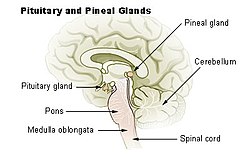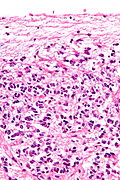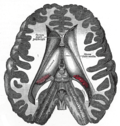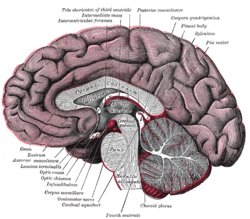Pineal gland
The pineal gland is a small endocrine gland in the middle of the brain of humans and other vertebrates. It makes and releases the hormone named melatonin.
There is almost no melatonin in the blood in the daytime. At the end of the day, melatonin in the blood allows sleepiness in humans and other animals which sleep at night. There is melatonin in the blood all night, while the person or animal is sleeping. In the morning, there is less and less melatonin in the blood. When light enters the eyes, the melatonin of the blood goes away.
Some people have circadian rhythm sleep disorders which make them sleepy much earlier or much later than normal. The most common one is Delayed Sleep-Phase Disorder (DSPD, or Delayed Sleep-Phase Syndrome, DSPS). People with DSPD usually go to bed at 3 in the morning or later but they sleep normally for at least eight hours.
Pineal Gland Media
Micrograph of a normal pineal gland – very high magnification
Micrograph of a normal pineal gland – intermediate magnification
Diagram of the operation of the pineal gland for Descartes in the Treatise of Man (figure published in the edition of 1664)
References
- Eakin R.M 1973. The third eye. Berkeley: University of California Press.
- Guyton A.C. & Hall J.E. 2001. Textbook of medical physiology. 10th ed, Saunders.
| Endocrine system |
| Adrenal gland - Corpus luteum - Hypothalamus - Ovaries - Pancreas - Parathyroid gland - Pineal gland - Pituitary gland - Testes - Thyroid gland - Hormone |











